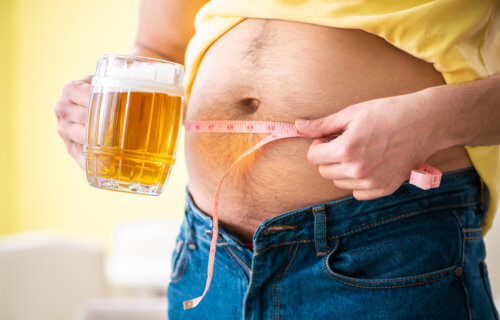WINSTON-SALEM, N.C. — Aiming to tone up and lose some excess fat is a fitness goal everyone can understand. When most people talk about “fat” however, they’re really referring to subcutaneous fat that’s just below the skin. While alcohol has an age-old link to this variety of fat in the form of “beer bellies,” researchers from Wake Forest University report that heavy drinking may also lead to the buildup of unhealthy ectopic fat around organs — including the heart, liver, and intestines.
What is ectopic fat?
The term “ectopic fat” refers to fat accumulating anywhere in the body it does not belong. A common example of ectopic fat is non-alcoholic fatty liver disease, a condition impacting roughly one in four U.S. adults, according to estimates.
These findings come from the Multi-Ethnic Study of Atherosclerosis (MESA), an ongoing research project that began back in 1999. The study aimed to understand the characteristics of subclinical cardiovascular disease, or disorders of the heart or blood vessels detected prior to the appearance of any actual clinical signs or symptoms, as well as any risk factors predicting progression to cardiovascular disease.
“Research shows that an excessive amount of alcohol is not good for heart health,” says Richard Kazibwe, M.D., an assistant professor of internal medicine at Wake Forest University School of Medicine and lead author of the study, in a university release. “Pericardial fat, or fat around the heart, is also associated with an increased risk of cardiovascular disease, so we wanted to better understand how alcohol intake might contribute to that risk.”
This latest project received funding from the National Heart, Lung and Blood Institute (NHLBI), part of the National Institutes of Health, and encompassed over 6,500 individuals of either European, African, Hispanic, or Asian descent between the ages of 45 and 84, all of whom were healthy at the time of enrollment.
MESA participants completed a personal-history questionnaire assessing their alcohol consumption habits. Depending on responses, participants were subsequently placed in one of six categories:
- Lifetime abstainers
- Former drinkers
- Light drinkers (less than one alcoholic drink daily)
- Moderate drinkers (one to two alcoholic drinks daily)
- Heavy drinkers (more than two alcoholic drinks daily)
- Binge drinkers (five or more alcoholic drinks in a single day without concurrent light, moderate, or heavy alcohol drinking)
Computerized tomography (CT) scans were also carried out among a subset of participants, allowing researchers to analyze data pertaining to the amount of fat that can build up in certain specific locations such as around the heart (pericardial fat) and in the liver (hepatic fat).
“The CT scans allow us to see deeper in the body to measure and gain a better understanding of how fat is distributed in the body. Body fat distribution can explain the differences in cardiovascular risk beyond the traditional measure of obesity such as body mass index. For instance, we know that two individuals with similar body mass index can have different cardiovascular risks,” Dr. Kazibwe explains.
The study reports heavy alcohol consumption and binge drinking, when compared with participants who abstained from alcohol, was indeed associated with significantly higher pericardial fat. These findings remained similar regarding other ectopic depots with the strongest associations for pericardial and hepatic.
“Interestingly, the lowest levels of ectopic fat were seen in people who reported light to moderate intake of alcohol,” Dr. Kazibwe comments.

When compared with beer and liquor or “hard” spirits, wine appeared less associated with higher pericardial fat. Dr. Kazibwe says one possible explanation for this finding may be the benefits of polyphenols, or beneficial compounds found in wine.
“Also, there are other characteristics to consider such as diet and exercise,” Dr. Kazibwe notes. “Wine drinkers might have better access to health care and have healthier lifestyles than non-wine drinkers.”
All in all, the study authors explain that the relationship between consuming alcohol and ectopic fat appears to follow a J-shaped pattern, which is considered a common way to visualize the marked increase in health risks relative to alcohol consumed. Dr. Kazibwe adds that numerous earlier studies have also reported a J-shaped relationship between alcohol consumption and cardiovascular risk; low-moderate alcohol consumption is tied to the lowest cardiovascular risks, and excessive alcohol intake is linked to a much higher risk.
“These findings are significant because both excessive alcohol intake and excess ectopic fat accumulation are known risk factors for cardiovascular disease,” Dr. Kazibwe adds. “It is also important to emphasize that given the well-documented health concerns caused by excessive alcohol consumption, it is important that people are aware of these potential risks.”
“These findings further solidify the relationship between drinking and cardiovascular risk and shed light on specific sub-clinical disease associated with excessive alcohol intake,” concludes Cashell Jaquish, Ph.D., a genetic epidemiologist and program officer at the NHLBI who also works with the MESA study. “Additional studies are needed to further clarify the role of ectopic fat distribution in the relationship between alcohol consumption and cardiovascular disease,”
The study is published in the Journal of the American Heart Association.
You might also be interested in:
- Best Celebrity Alcohol Brands: Top 5 Famous Spirits Most Recommended By Experts
- Cheers! Scientists may finally know why light drinking is good for heart health
- Fatty Liver Disease Ups Personality Disorder Risk – Three Times More Likely Than Others

